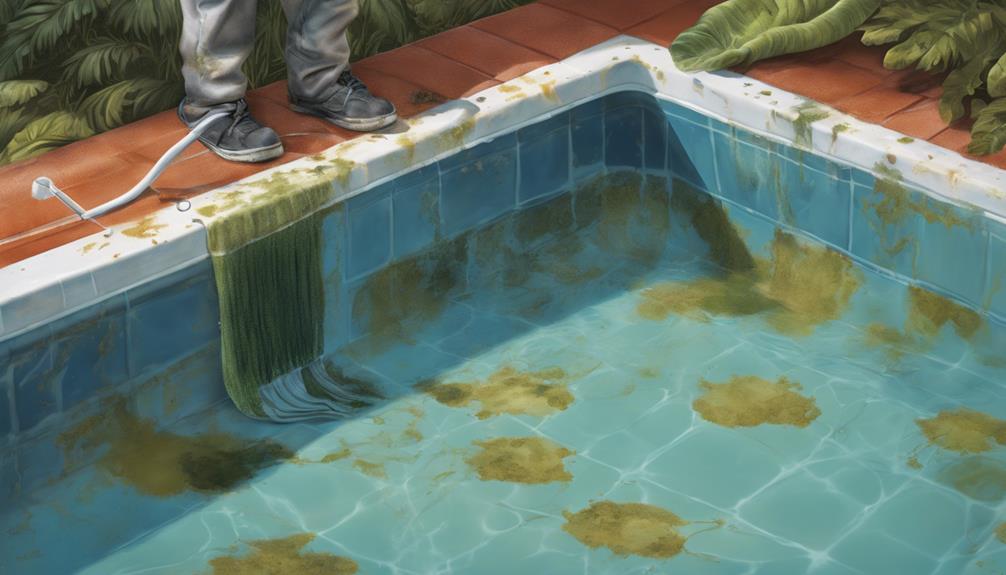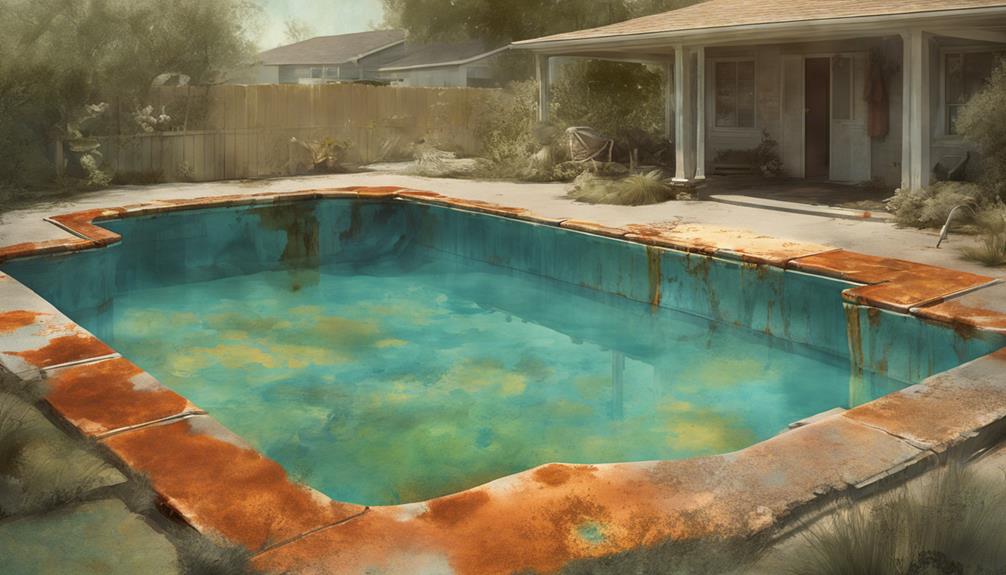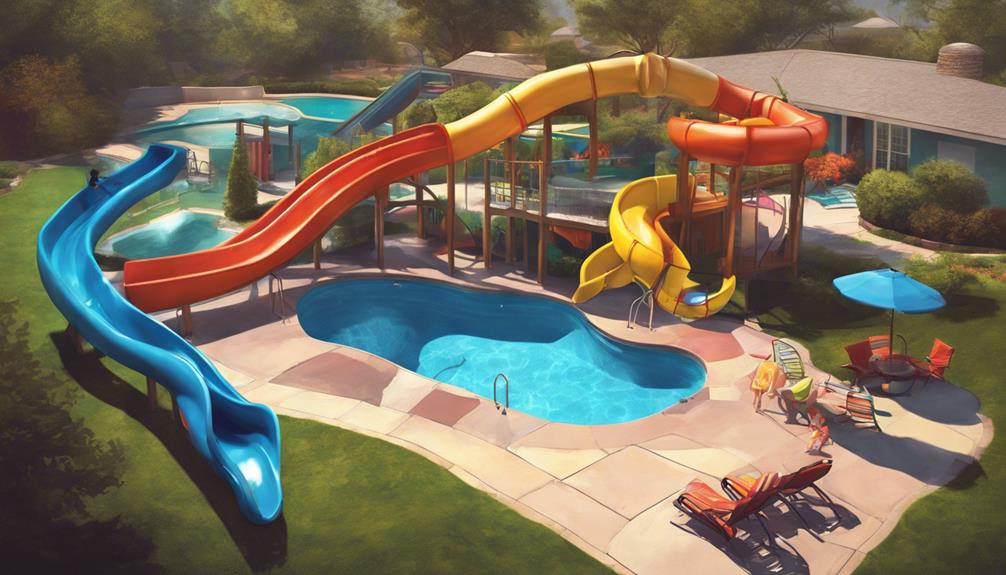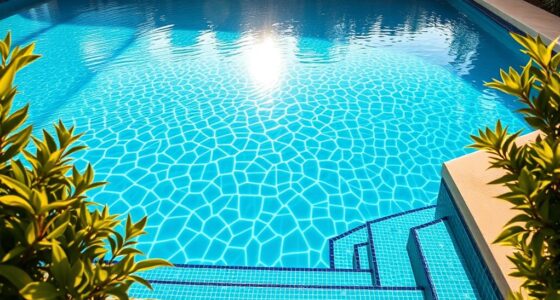Properly evaluate and detect pool liner stains by recognizing whether they stem from organic or metal sources. Organic stains typically look brown or green because of debris such as leaves and algae, while metal stains come in colors like blue-green, yellow, reddish-brown, black, or purple. Implement preventive measures through routine maintenance and cleaning to effectively handle stains. Familiarize yourself with specialized methods for removing both organic and metal-based discolorations to eliminate pool liner stains and achieve a spotless pool appearance.
Key Takeaways
- Regularly inspect for stain types: organic (brown/green) or metal (blue-green, yellow, black).
- Test pool water for metal content before stain removal.
- Use pool stain removers specific to stain type.
- Maintain balanced water chemistry to prevent and treat stains.
- Seek professional help if stains persist despite efforts.
Assessing Pool Liner Stains
Regularly examining pool liner stains is vital to identify the type of stains present and effectively plan for their removal.
Stains can arise from organic sources like mud, leaves, and algae, or from metals such as copper, iron, and manganese. Organic stains commonly appear brown or green, while metal stains exhibit distinct colors like blue-green, yellow, reddish-brown, black, or purple.
Identifying the origin of the stain is essential before attempting any removal methods.
Regular maintenance and cleaning practices can help in preventing and managing stains.
Identifying Stain Types
To effectively address pool liner stains, an essential initial step is accurately identifying the type of stain present, whether originating from organic sources like mud and algae or from metals such as copper, iron, and manganese. When determining the type of stain on your pool liner, consider the following:
- Organic Stains:
- Typically brown or green.
- Often caused by debris like leaves and algae.
- Metal Stains:
- Colors vary: blue-green (copper), yellow or reddish-brown (iron), black or purple (manganese).
- Copper stains can come from heating systems; iron stains from rusting items near the pool.
- Sources of Metal Stains:
- Copper stains can be due to poor-quality salts in the pool.
- Iron stains may result from rusting pool accessories.
- Prevention of Metal Stains:
- Regularly test pool water for metal content.
- Use metal-specific stain removers for effective treatment.
Removing Organic Stains

Efficiently eliminating organic stains from pool liners involves thorough cleaning techniques to remove debris like mud, leaves, and algae.
To start, ensure the pool water and filter are free of any organic matter by vacuuming and scrubbing the pool surface.
Testing the pool water for chlorine and pH levels is important before treatment to prevent any adverse reactions.
If the organic stains prove stubborn, consider using pool stain removers specifically designed for organic stains.
Additionally, proper storage of chemicals is crucial to avoid any hazards to children or pets.
Regular maintenance and cleaning routines can help prevent the buildup of organic stains, preserving the pristine look of your pool liner for a longer period.
Treating Metal Stains
Thoroughly evaluating the type of metal stain present in your pool liner is essential before initiating any treatment methods. When dealing with metal stains, follow these steps:
- Identify the Metal: Determine if the stain is from copper (blue-green), iron (yellow or reddish-brown), or manganese (black or purple).
- Balance Water Chemistry: Maintain proper chemical levels to prevent exacerbating the stain.
- Use Specific Cleaners: Employ metal stain removers designed for your pool liner material.
- Seek Professional Help: If stains persist despite efforts, consult a pool expert for tailored advice.
Taking these steps can effectively treat metal stains and maintain the beauty of your pool liner.
Pool Liner Care Essentials

When maintaining your pool liner, prioritizing proper care and maintenance routines is essential for preserving its longevity and appearance.
Regularly cleaning the pool liner surface with a soft brush and mild detergent can help prevent the build-up of dirt and debris.
Additionally, checking and adjusting the pool's water chemistry levels, such as pH and chlorine, is crucial for preventing stains and maintaining the liner's integrity.
Properly storing pool chemicals away from sunlight and moisture can also contribute to prolonging the lifespan of the liner.
Lastly, scheduling routine inspections and professional cleanings can help address any issues early on and ensure that your pool liner stays in top-notch condition for years to come.
Frequently Asked Questions
How Can I Prevent Stains on My Pool Liner?
Preventing stains on your pool liner involves regular maintenance and cleaning. Removing debris promptly, balancing water chemistry, and addressing stains early can help maintain a pristine pool liner. Seeking professional advice for persistent stains is recommended for best care.
Are There Any Natural Remedies for Removing Pool Stains?
Natural remedies for removing pool stains include using baking soda, vinegar, and lemon juice. These household items can help break down organic stains and are environmentally friendly. However, for persistent or metal stains, consulting a professional is recommended.
Can Using Too Many Chemicals Cause Pool Liner Stains?
Excessive use of chemicals in pools can lead to imbalanced water chemistry, potentially causing pool liner stains. It is essential to maintain proper chemical levels, follow manufacturer guidelines, and regularly monitor water quality to prevent staining issues.
What Should I Do if I Accidentally Spill a Stain-Causing Substance in My Pool?
If you accidentally spill a stain-causing substance in your pool, promptly remove the source, assess the type of stain, and consult with a pool care professional for tailored guidance on safe and effective stain removal methods.
Are There Any DIY Methods to Test for the Type of Pool Liner Stain?
In the pursuit of banishing pool liner stains, DIY methods can aid in identifying the type of stain. Utilize simple household items like vitamin C tablets or a chlorine tablet to conduct a preliminary test before initiating stain removal procedures.
Are Pool Liner Stains Common in Newly Constructed Pools?
Pool liner stains are a common concern in newly constructed pools. However, with proper pool construction mastery techniques, these stains can be prevented. It’s important to carefully select materials and maintain proper water chemistry to avoid discoloration and blemishes on the pool liner.
Conclusion
In the intricate tapestry of pool maintenance, the battle against stubborn pool liner stains demands a keen eye and strategic approach.
By understanding the origins of these blemishes and employing targeted cleaning methods, pool owners can restore the pristine beauty of their oasis.
Just as a painter delicately brushes away imperfections on a canvas, meticulous care and proactive maintenance will guarantee your pool liner remains a shimmering masterpiece for years to come.










